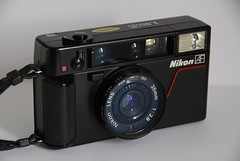Difference between revisions of "Nikon L35AF"
| Line 12: | Line 12: | ||
== Specifications == | == Specifications == | ||
* [[35mm]] film camera | * [[35mm]] film camera | ||
| − | * Lens: 35mm f/2.8 with autofocus from 0.8m to infinity. It had | + | * Lens: 35mm f/2.8 with autofocus from 0.8m to infinity. It had 5 elements in 4 groups. 46mm filter thread. |
* Exposure: Fully automatic, range EV 6 (f/2.8 at 1/8 sec.) to EV 17 (f/17.5 at 1/430 sec.) with ASA/ISO 100 film | * Exposure: Fully automatic, range EV 6 (f/2.8 at 1/8 sec.) to EV 17 (f/17.5 at 1/430 sec.) with ASA/ISO 100 film | ||
| − | * Features: Integral flash | + | Film Speed Range: 50 ASA/ISO - 1000 ASA/ISO |
| + | * Features: Integral flash | ||
| + | *Power: two AA alkaline batteries. | ||
== References == | == References == | ||
<references /> | <references /> | ||
Revision as of 17:45, 2 March 2010

|
| Nikon L35AF by Final Approach. |
The L35AF was Nikon's first compact camera with autofocus. It was released in 1983, a few years after Nikon's competitors had opened up the point and shoot market. It was therefore also the first in the L series. It was an immediate hit thanks to its robust design and excellent specification. It has subsequently become a cult classic among collectors. A version with an "autodate" function was called the L35AD.
The L35AF was given the nickname 'Pikaichi' ("top notch") in Japan.[1]The lens was designed by Koichi Wakamiya as an update to the Sonnar formula.[2]
Specifications
- 35mm film camera
- Lens: 35mm f/2.8 with autofocus from 0.8m to infinity. It had 5 elements in 4 groups. 46mm filter thread.
- Exposure: Fully automatic, range EV 6 (f/2.8 at 1/8 sec.) to EV 17 (f/17.5 at 1/430 sec.) with ASA/ISO 100 film
Film Speed Range: 50 ASA/ISO - 1000 ASA/ISO
- Features: Integral flash
- Power: two AA alkaline batteries.
References
- ↑ Article about L35AF lens design at imaging.nikon.com
- ↑ Article about L35AF lens design at imaging.nikon.com
Links
- L35AF/L35AD on Nikon Imaging official website.
- Nikon L35AF in Sylvain Halgand's collection.